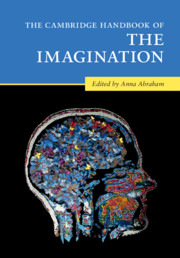Book contents
- The Cambridge Handbook of the Imagination
- The Cambridge Handbook of the Imagination
- Copyright page
- Dedication
- Contents
- Figures
- Contributors
- Acknowledgments
- 1 Surveying the Imagination Landscape
- Part I Theoretical Perspectives on the Imagination
- Part II Imagery-Based Forms of the Imagination
- Part III Intentionality-Based Forms of the Imagination
- Part IV Novel Combinatorial Forms of the Imagination
- Part V Phenomenology-Based Forms of the Imagination
- Part VI Altered States of the Imagination
- 40 Dreaming: Beyond Imagination and Perception
- 41 Dreaming is Imagination Roaming Freely, Based On Embodied Simulation, and Subserved by an Unconstrained Default Network
- 42 Aphantasia
- 43 Hypnosis and Imagination
- 44 Hallucinations and Imagination
- 45 The Psychiatry of Imagination
- 46 Meditation and Imagination
- 47 Flow in Performance and Creative Cognition – An Optimal State of Task-Based Adaptation
- 48 The Force of the Imagination
- Name Index
- Subject Index
- References
45 - The Psychiatry of Imagination
from Part VI - Altered States of the Imagination
Published online by Cambridge University Press: 26 May 2020
- The Cambridge Handbook of the Imagination
- The Cambridge Handbook of the Imagination
- Copyright page
- Dedication
- Contents
- Figures
- Contributors
- Acknowledgments
- 1 Surveying the Imagination Landscape
- Part I Theoretical Perspectives on the Imagination
- Part II Imagery-Based Forms of the Imagination
- Part III Intentionality-Based Forms of the Imagination
- Part IV Novel Combinatorial Forms of the Imagination
- Part V Phenomenology-Based Forms of the Imagination
- Part VI Altered States of the Imagination
- 40 Dreaming: Beyond Imagination and Perception
- 41 Dreaming is Imagination Roaming Freely, Based On Embodied Simulation, and Subserved by an Unconstrained Default Network
- 42 Aphantasia
- 43 Hypnosis and Imagination
- 44 Hallucinations and Imagination
- 45 The Psychiatry of Imagination
- 46 Meditation and Imagination
- 47 Flow in Performance and Creative Cognition – An Optimal State of Task-Based Adaptation
- 48 The Force of the Imagination
- Name Index
- Subject Index
- References
Summary
Psychiatric disorders provide unique insights into imagination, because they represent extremes of evolved adaptations and trade-offs. I review imagination in the two main sets of disorders of human social and imaginative cognition: the autism spectrum and the psychotic affective spectrum. To do so, I first operationally define imagination in terms of its components, then discuss how seven major aspects of imagination – pretend play, creativity, narrative and the arts, mental time travel, salience, mental imagery and sensory systems, and neural system instantiating it – are altered in autism and psychotic-affective spectrum conditions, mainly with reference to schizophrenia. I then relate fluid intelligence to imagination, and both of them to autism and schizophrenia, genetically and phenotypically. By this narrative review, the autism spectrum involves, overall, lower imagination (and higher aspects of intelligence), while schizophrenia involves higher aspects of imagination (but lower intelligence). Autism and psychotic-affective disorders provide novel opportunities to analyze the causes and consequences of increased, and reduced, imagination, with direct implications for mental-disorder therapies, and enhancements of imagination and creativity among relatively neurotypical individuals.
- Type
- Chapter
- Information
- The Cambridge Handbook of the Imagination , pp. 760 - 782Publisher: Cambridge University PressPrint publication year: 2020
References
- 3
- Cited by



